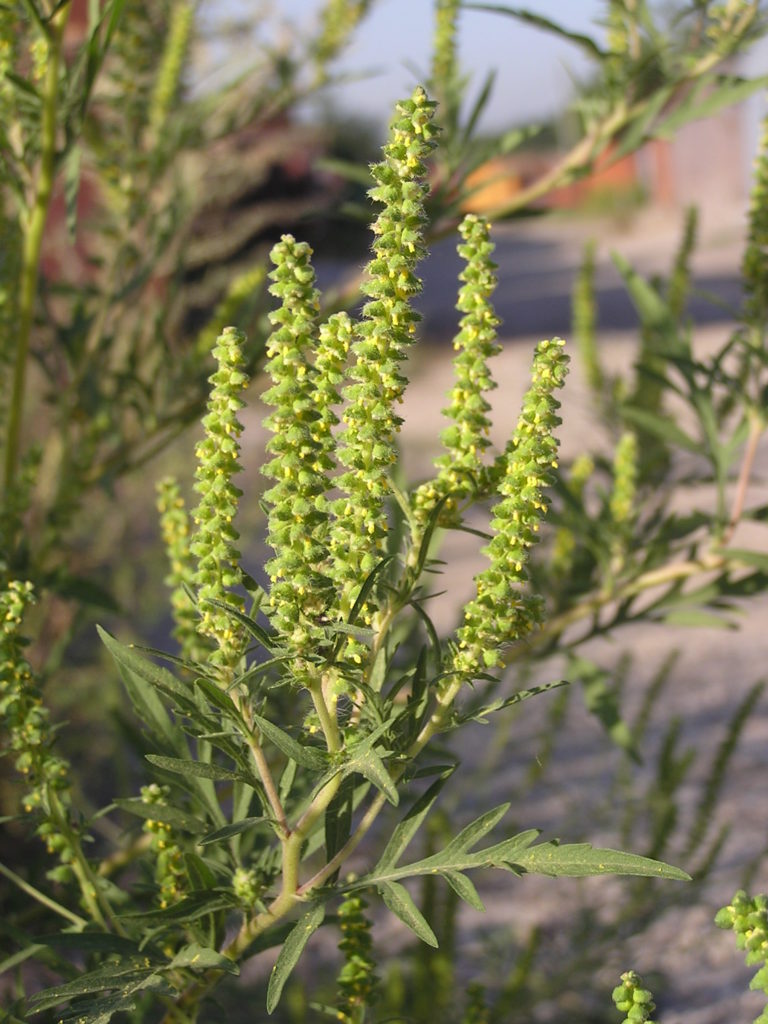Scientific name: Ambrosia artemisiifolia
Common names: Ragweed, bursages, burrobrushes
Scientific name: Ambrosia trifidia
Common names: giant ragweed, tall ragweed, blood ragweed, perennial ragweed
Family: Asteraceae
Article by Jeanne Gozigian
Each year by December most of the USA has undergone at least one killing frost. What a relief this is to the 5-10% of America’s population who are allergic to pollens. Of these, 75% are allergic to ragweed pollen. Hay fever, or allergic rhinitis, results – itching bleary eyes, runny noses, sneezing, scratchy throats; all make sufferers miserable. Untreated, it can turn into asthma and other breathing difficulties. Alas, I am one of those sufferers. A killing frost puts an end to windblown pollen dispersal.

Andrew Butko, CC BY-SA 3.0 <https://creativecommons.org/licenses/by-sa/3.0>, via Wikimedia Commons
Ironically, Ambrosia, from the Greek, means “food or drink of immortality”. A ragweed pollen grain, under magnification, is a nasty looking spiked ball, capable of traveling 300-400 miles from source plants.

By Marie Majaura – Own work, CC BY-SA 3.0, https://commons.wikimedia.org/w/index.php?curid=3105491
Up to 1 billion grains of pollen are dispersed during the season, late summer in the USA. Rather the opposite of ambrosia! The recent rapid spread of ragweed is thought to be due to climate change. Warming of the planet is causing this once sub -tropical plant to be happy in more northerly climates, like New York State, where it is listed as an agricultural, waste area and garden weed. It certainly made my life miserable, growing up in upstate New York. Ragweeds were among the first weeds to develop herbicide resistance.
Ragweed is a monoecious (having both male and female parts on the same plant) annual or perennial plant. A. artemisiifolia (the leaves resemble Artemisia leaves) can be from 4 inches to 13 feet high. Some of the ragweed along the Rio Grande bosque, where I used to live, towered over my head like small trees, undoubtedly taking advantage of the underground water supply. The alternate, blue-green leaves are pinnate or palmate, palmate in giant ragweed. The stems arise from rhizomes. The spike or raceme infloresence of bright green flowers occur at the ends of branches. Bushy, shrub-like plants have a medicinal smell. Leaves are hairy on tops or bottoms. Upper leaves often have no petioles.
A.trifidia, giant ragweed, can be 3 feet to 12 feet tall, leaves up to 12 inches long and 8 inches across. The green raceme can be 3 to 6 inches long. The tough seeds can remain viable in the soil for several years. The seeds of this and A. artemisifolia can be useful as food for birds and rodents but the foliage is distasteful to most mammals except for goats. Trifidia is Latin for cut in three parts, referring to its palmate shaped leaves. Its primary spread is as a contaminant of agricultural seeds. All ragweeds grow from Canada to the United States and into Northern Mexico.

Ambrosia trifidia leaf. Photo credit: Image Archive of Central Texas Plants, Univ. of Texas at Austin.
Ironically, ragweed seeds can be ordered online. Who would want to grow it?
How can we help those unfortunates who suffer from pollen allergens? It is best to rely on immunotherapy – start treatment before the allergy season begins with shots. Watch daily pollen counts in season and stay indoors when it is high. Shower and wash clothes immediately after having to be outdoors. Keep windows closed, especially in early morning. It can be useful to move to higher elevations which do not support ragweed growth. I retreated to the Adirondack mountains in my teens for relief. Treat symptoms with medicines such as antihistamines.
Poor chamisa, a.k.a., rabbitbrush (Ericameria nauseosa), the golden flowered perennial shrub so ubiquitous in the desert southwest, often takes the rap for being the cause of hay fever. Not so! Chamisas are pollinated by bees, butterflies and birds; their pollens are not windborne. Likewise, goldenrods, yellow flowering species in the Asteraceae family prevalent in the eastern United States, which are also unfortunately blooming when ragweed is dispersing its pollen, are unfairly blamed. I have had many arguments, frequently to no avail, trying to convince folks that they are NOT allergic to chamisa!
Eradication of ragweed is very difficult due to its resistance to herbicide and rapid spread. Jack Sanders, author of The Secret of Wildflowers, says that he and his children used to pull up ragweed plants when they were hiking; obviously, this will never be an effective method. For allergy sufferers, it is dangerous.
ACHOO! God bless you!

Ragweed (Ambrosia artemisiifolia). Photo by John Hilty, Illinois Wildflowers
Sources:
CABI, 2021. Ambrosia trifidia (giant ragweed) In: Invasive Species Compendium. Wallingford, UK: CAB International. www.cabi.org/isc.
“Common Ragweed”. Cornell Weed Identification. Web. 7 Sept. 2021. Retrieved from: https://blogs.cornell.edu/weedid/field-crops/common-ragweed-ambrosia-artemisiifolia/
Hilty, John. “Giant ragweed (Ambrosia trifidia)”. Weedy Wildflowers of Illinois. Web. 10 Sept 2021. Retrieved from: https://www.illinoiswildflowers.info/weeds/plants/giant_ragweed.htm
Harrison, Lorraine. Latin for Gardeners. The University of Chicago Press, Chicago 6037, 2012
“Ragweed Allergy”. WebMD. Web. 16 Aug. 2021. Retrieved from: webmd.com/allergies/ragweed-allergy
“Ragweed Allergy”. Allergy Partners. 16 Aug 2017. Web. 7 Sept 2021. Retrieved from: https://www.allergypartners.com/ragweed-allergy/
Saunders, Jack. The Secrets of Wildflowers. The Lyons Press, Guildford, CT, 66437, 2003
Wikipedia contributors. (2021, August 14). Ambrosia artemisiifolia. In Wikipedia, The Free Encyclopedia. Retrieved 05:37, November 27, 2021, from https://en.wikipedia.org/w/index.php?title=Ambrosia_artemisiifolia&oldid=1038751593
Wikipedia contributors. (2021, September 18). Ambrosia trifida. In Wikipedia, The Free Encyclopedia. Retrieved 05:39, November 27, 2021, from https://en.wikipedia.org/w/index.php?title=Ambrosia_trifida&oldid=1045041222
Witson, Tom D., et al., Weeds of the West, 5th Edition, 1996, University of Wyoming


